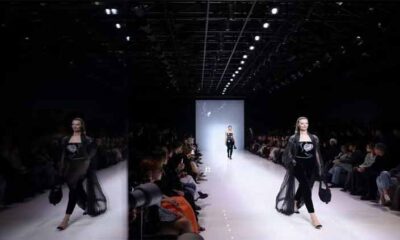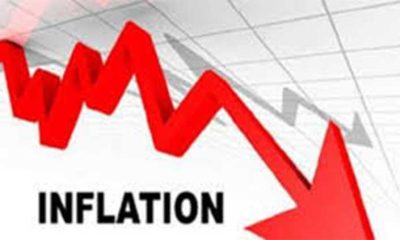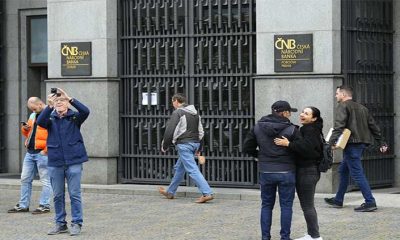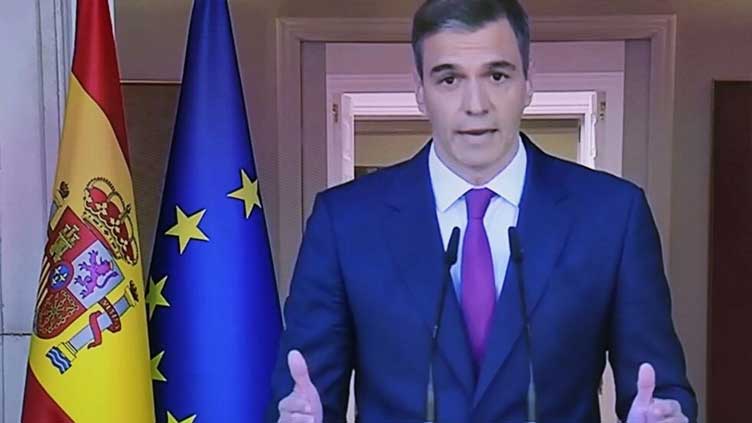Alexei Navalny, Russia’s top opposition leader and President Vladimir Putin’s fiercest foe, died in prison on Friday, a statement from the Federal Penitentiary Service said.
Navalny, who was serving a 19-year sentence on charges of extremism, felt unwell after a walk and collapsed, it said. The politician’s team had no immediate confirmation of his death.
Navalny was moved in December from his former prison in central Russia to to a “special regime” penal colony — the highest security level of prisons in Russia — above the Arctic Circle.
In a span of a decade, he went from being the Kremlin’s biggest foe to Russia’s most prominent political prisoner.
Here’s a look at key events in Navalny’s life, political activism and the charges he has faced through the years:
June 4, 1976 — Navalny is born in a western part of the Moscow region.
1997 — Graduates from Russia’s RUDN university, where he majored in law; earns a degree in economics in 2001 while working as a lawyer.
2004 — Forms a movement against rampant overdevelopment in Moscow, according to his campaign website.
2008 — Gains notoriety for alleging corruption in state-run corporations, such as gas giant Gazprom and oil behemoth Rosneft, through his blogs and other posts.
2010 — Founds RosPil, an anti-corruption project run by a team of lawyers that analyzes spending of state agencies and companies, exposing violations and contesting them in court.
2011 — Establishes the Foundation for Fighting Corruption, which will become his team’s main platform for exposing alleged graft among Russia’s top political ranks.
December 2011 — Participates in mass protests sparked by reports of widespread rigging of Russia’s parliamentary election, and is arrested and jailed for 15 days for “defying a government official.”
March 2012 — Following President Vladimir Putin’s reelection and inauguration, mass protests break out in Moscow and elsewhere. Navalny accuses key figures, including then-Deputy Prime Minister Igor Shuvalov and Chechnya’s strongman leader, Ramzan Kadyrov, of corruption.
July 2012 — Russia’s Investigative Committee charges Navalny with embezzlement involving Kirovles, a state-owned timber company in the Kirov region, while acting as an adviser to the local governor. Navalny rejects the allegations as politically motivated.
December 2012 — The Investigative Committee launches another probe into alleged embezzlement at a Navalny-linked Russian subsidiary of Yves Rocher, a French cosmetics company. Navalny again says the allegations are politically motivated.
2013 — Navalny runs for mayor in Moscow — a move the authorities not only allow but encourage in an attempt to put a veneer of democracy on the race that is designed to boost the profile of the incumbent, Sergei Sobyanin.
July 2013 — A court in Kirov convicts Navalny of embezzlement in the Kirovles case, sentencing him to five years in prison. The prosecution petitions to release Navalny from custody pending his appeal, and he resumes his campaign.
September 2013 — Official results show Navalny finishes second in the mayor’s race behind Sobyanin, with 27% of the vote, after a successful electoral and fundraising campaign collecting an unprecedented 97.3 million rubles ($2.9 million) from individual supporters.
October 2013 — A court hands Navalny a suspended sentence in the Kirovles case.
February 2014 — Navalny is placed under house arrest in connection with the Yves Rocher case and banned from using the internet. His blog continues to be updated regularly, presumably by his team, detailing alleged corruption by various Russian officials.
December 2014 — Navalny and his brother, Oleg, are found guilty of fraud in the Yves Rocher case. Navalny receives a 3 ½-year suspended sentence, while his brother is handed a prison term. Both appeal to the European Court of Human Rights.
December 2015 — Navalny’s Foundation for Fighting Corruption releases its first long-form video — a YouTube documentary called “Chaika,” which means “seagull” in Russian but is also the last name of then-Prosecutor General Yury Chaika. The 44-minute video accuses him of corruption and alleged ties to a notorious criminal group and has piled up 26 million views on YouTube. Chaika and other Russian officials deny the accusations.
February 2016 — The European Court of Human Rights rules that Russia violated Navalny’s right to a fair trial in the Kirovles case, ordering the government to pay his legal costs and damages.
November 2016 — Russia’s Supreme Court overturns Navalny’s sentence and sends the case back to the original court in the city of Kirov for review.
December 2016 — Navalny announces he will run in Russia’s 2018 presidential election.
February 2017 — The Kirov court retries Navalny and upholds his five-year suspended sentence from 2013.
March 2017 — Navalny releases a YouTube documentary accusing then-Prime Minister Dmitry Medvedev of corruption, getting over seven million views in its first week. A series of anti-graft protests across Russia draw tens of thousands and there are mass arrests. Navalny tours the country to open campaign offices, holds big rallies and is jailed repeatedly for unauthorized demonstrations.
April 27, 2017 — Unidentified assailants throw a green disinfectant in his face, damaging his right eye. He blames the attack on the Kremlin.
October 2017 — The European Court of Human Rights finds Navalny’s fraud conviction in the Yves Rocher case to be “arbitrary and manifestly unreasonable.”
December 2017 — Russia’s Central Electoral Commission bars him from running for president over his conviction in the Kirovles case, a move condemned by the EU as casting “serious doubt” on the election.
July 2019 — Members of Navalny’s team, along with other opposition activists, are barred from running for Moscow city council, sparking protests that are violently dispersed, with thousands arrested. Navalny’s team responds by promoting the “Smart Voting” strategy, encouraging the election of any candidate except those from the Kremlin’s United Russia party. The strategy works, with the party losing its majority.
2020 — Navalny seeks to deploy the Smart Voting strategy during regional elections in September and tours Siberia as part of the effort.
Aug. 20, 2020 — On a flight from the city of Tomsk, where he was working with local activists, Navalny falls ill and the plane makes an emergency landing in nearby Omsk. Hospitalized in a coma, Navalny’s team suspects he was poisoned.
Aug. 22, 2020 — A comatose Navalny is flown to a hospital in Berlin.
Aug. 24, 2020 — German authorities confirm Navalny was poisoned with a Soviet-era nerve agent. After he recovers, he blames the Kremlin, an accusation denied by Russian officials.
Jan. 17, 2021 — After five months in Germany, Navalny is arrested upon his return to Russia, with authorities alleging his recuperation abroad violated the terms of his suspended sentence in the Yves Rocher case. His arrest triggers some of the biggest protests in Russia in years. Thousands are arrested.
Feb. 2, 2021 — A Moscow court orders Navalny to serve 2 ½ years in prison for his parole violation. While in prison, Navalny stages a three-week hunger strike to protest a lack of medical treatment and sleep deprivation.
June 2021 — A Moscow court outlaws Navalny’s Foundation for Fighting Corruption and about 40 regional offices as extremist, shutting down his political network. Close associates and team members face prosecution and leave Russia under pressure. Navalny maintains contact with his lawyers and team from prison, and they update his social media accounts.
Feb. 24, 2022 — Russia invades Ukraine. Navalny condemns the war in social media posts from prison and during his court appearances.
March 22, 2022 — Navalny is sentenced to an additional nine-year term for embezzlement and contempt of court in a case his supporters rejected as fabricated. He is transferred to a maximum-security prison in Russia’s western Vladimir region.
July 2022 — Navalny’s team announces the relaunch of the Anti-Corruption Foundation as an international organization with an advisory board including Francis Fukuyama, Anne Applebaum, and the European Parliament member and former Belgian Prime Minister Guy Verhofstadt. Navalny continues to file lawsuits in prison and tries to form a labor union in the facility. Officials respond by regularly placing him in solitary confinement over purported disciplinary violations such as failing to properly button his garment or to wash his face at a specified time.
2023 — Over 400 Russian doctors sign an open letter to Putin, urging an end to what it calls abuse of Navalny, following reports that he was denied basic medication after getting the flu. His team expresses concern about his health, saying in April he had acute stomach pain and suspected he was being slowly poisoned.
March 12, 2023 — “Navalny,” a film about the attempt on the opposition leader’s life, wins the Oscar for best documentary feature.
April 26, 2023 — Appearing on a video link from prison during a hearing, Navalny says he was facing new extremism and terrorism charges that could keep him behind bars for the rest of his life. He adds sardonically that the charges imply that “I’m conducting terror attacks while sitting in prison.”
June 19, 2023 — The trial begins in a makeshift courtroom in the Penal Colony No. 6 where Navalny is held. Soon after it starts, the judge closes the trial to the public and media despite Navalny’s objections.
July 20, 2023 — In closing arguments, the prosecution asks the court to sentence Navalny to 20 years in prison, his team reports. Navalny says in a subsequent statement that he expects his sentence to be “huge … a Stalinist term,” referring to Soviet dictator Josef Stalin.
Aug. 4, 2023 — Navalny is convicted of extremism and sentenced to 19 years, and he says he understands he’s “serving a life sentence, which is measured by the length of my life or the length of life of this regime.”
Russian opposition leader Alexei Navalny, 2nd left, and his lawyers Alexander Fedulov, left, Olga Mikhailova, right, and Vadim Kobzev, second right, are seen on a TV screen standing among his lawyers, as he appears in a video link provided by the Russian Federal Penitentiary Service, during a hearing in the colony, in Melekhovo, Vladimir region, about 260 kilometers (163 miles) northeast of Moscow, Russia, on Friday, Aug. 4, 2023. (AP Photo, File)
Russian opposition leader Alexei Navalny, 2nd left, and his lawyers Alexander Fedulov, left, Olga Mikhailova, right, and Vadim Kobzev, second right, are seen on a TV screen standing among his lawyers, as he appears in a video link provided by the Russian Federal Penitentiary Service, during a hearing in the colony, in Melekhovo, Vladimir region, about 260 kilometers (163 miles) northeast of Moscow, Russia, on Friday, Aug. 4, 2023. (AP Photo, File)
Oct. 13, 2023 — Authorities detain three lawyers representing Navalny after searching their homes, and his ally Ivan Zhdanov says on social media the move is a bid to “completely isolate Navalny.” The raids targeting Vadim Kobzev, Igor Sergunin and Alexei Liptser are part of a criminal case on charges of participating in an extremist group, Zhdanov says. Navalny’s spokesperson says if the opposition leader has no access to lawyers, “he will end up in complete isolation, the kind no one can really even imagine.”
Dec. 2, 2023 — New charges are filed against Navalny. In comments passed to associates, Navalny says he has been charged under Article 214 of the penal code, covering vandalism. “I don’t even know whether to describe my latest news as sad, funny or absurd,” he writes on social media via his team. “I have no idea what Article 214 is, and there’s nowhere to look. You’ll know before I do.”
Dec. 7, 2023 — Navalny’s team erects billboards across Russia featuring QR codes that lead smartphones to a hidden website urging Russians to take part in a campaign against Putin, who is expected to run for reelection in March 2024. Navalny’s team say the vote is important for Putin as a referendum on his war in Ukraine, rather than a real contest for the presidency.
Dec. 11, 2023 — Navalny is scheduled to appear in court via video link but does not appear, and his spokeswoman says prison officials are citing electricity problems. Navalny’s allies express concern, saying neither they nor his lawyers have heard from him in several weeks.
Dec. 25, 2023 — Navalny’s allies say he’s been located in a prison colony in the town of Kharp, north of the Arctic Circle, notorious for long and severe winters. It’s about 100 kilometers (60 miles) from Vorkuta, whose coal mines were among the harshest of the Soviet Gulag prison-camp system.
Jan. 10 — Navalny appears via video link from Kharp for the first time. Russian news outlets release images of him in black prison garb and with a buzz cut, on a live TV feed from the “special regime” penal colony in Kharp, about 1,900 kilometers (1,200 miles) northeast of Moscow. At the hearing, Navalny cracks jokes about Arctic weather and asks if officials at his former prison threw a party when he was transferred.
Feb. 16 — Russia’s Federal Penitentiary Service says Navalny died in prison at the age of 47. It says he felt unwell after a walk and collapsed. An ambulance arrived but could not resuscitate him. Navalny’s team says it has no confirmation of his death and that his lawyer is on the way to the Kharp penal colony.
Post Views: 38


 Sports3 months ago
Sports3 months ago
 Fashion2 months ago
Fashion2 months ago
 Sports3 months ago
Sports3 months ago
 pakistan3 months ago
pakistan3 months ago
 pakistan3 months ago
pakistan3 months ago
 World2 months ago
World2 months ago
 World2 months ago
World2 months ago
 Sports2 months ago
Sports2 months ago




















